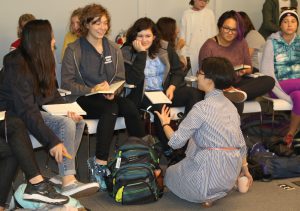By Julia Zimmerman

Twenty-eight students from The Sage School in Hailey participated in the West Coast’s largest climate justice march held Saturday, Sept. 8. Over six days in San Francisco, the event touched on issues affected by climate change, such as society, social movements, and immigration.
Having a voice and being empowered to express it was riveting for many students, especially those grappling with the discrepancies of what they’re learning in science and messages from the media.
“Seeing all of these people united on this one problem, it was really powerful,” said Coco Vorm, an eighth-grader.
Organizers of the Rise for Climate, Jobs, and Justice March urged support for community-led solutions, which aligns with The Sage School’s mission to promote community responsibility through weekly service projects and a human ecology curriculum interwoven into five weeks of field study.
“To honor adolescents, learning has got to be active, diverse, and relevant,” said Nathan Kolar, The Sage School’s Human Ecology team leader. “We want our eighth and ninth graders transitioning to high school able to understand elements of social structure, like laws, social and political hierarchies, distribution of human habitation and labor, and the influence of the built environment.”
More than 300 organizations represented in the Rise for Climate Justice March believe that real climate leadership needs to address unsustainable environmental practices as well as the racial, social and economic injustices faced by those most impacted by the climate crisis—low-income immigrant communities, indigenous communities and communities of color.
One eighth-grader, Julian Lohmman, was reluctant to see the March as an instrument of large-scale change but was happy to be a part of an event that got people thinking.
“I don’t know if the Rise for Climate Justice March one-hundred percent changed everything, but hopefully it changed something,” Lohmann said.
Exploring the relationship between environmental health and social injustice is challenging, but something The Sage School believes teenagers are quite capable of.
“Students have unique perspectives that many adults miss, and they are capable of coming up with creative solutions to complex problems,” said Maggie Blatz, Sage School, Human Ecology team teacher.
For example, during a Q&A session at Mother Jones Magazine, students peppered immigration editor Ian Gordon with a bevy of prepared questions: How hard is it to become a legal immigrant to the U.S.? What happens if a country decides to have open borders? How have immigrants affected the U.S. economy? What if immigration didn’t even exist?
In addition to the Climate Justice March, students attended several affiliate events designed to promote the development of informed opinions on climate change in advance of this week’s Global Climate Action Summit.
Students also attended Coal+Ice, a documentary photography and video exhibition featuring the work of 40 photographers examining the effects of climate change caused by the burning of fossil fuels.
Sitting among the strategically-placed, auditory-enhanced, large-scale, projected photography panels while meditating on the messages was “dramatic, emotional, and provocative,” said Asia Angel, an eighth-grader.
After each event, students gathered for a debriefing guided by six adult chaperones, offering counter-perspectives.
A great deal of the six-day San Francisco field study concentrated on the power of narratives and the creative use of different media to tell stories. Students attended an outdoor production of Lin-Manuel Miranda’s “In the Heights,” a musical set in the largely Hispanic-American neighborhood of Washington Heights in New York City. Miranda used contemporary music to explore several themes: hope in times of adversity, the importance of family ties, and the struggles faced by individuals living within a minority immigrant community.
To strengthen their understanding of how art, technology and design is used in effective storytelling, students also toured several museum exhibits, including the “Veiled Meanings” exhibit at the Jewish Contemporary Museum, which featured clothing that told the story of Jewish trade and cultural assimilation across Europe, the Middle East, Asia, and northern Africa.
Sage School students ended their field study by participating in a community-building circle led by the co-director of Reformative Justice for Oakland Youth, an organization working to eliminate the inner-city schools-to-prison pipeline using an approach rooted in indigenous cultures. Their philosophy: that when young people are given a chance to repair harm instead of being punished, they begin to understand that what they do matters.
Starting the year in an intensive field-study experience sets students up to return to the classroom, motivated and inspired to further their studies of race, class, justice, and environmental relations.
